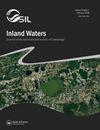The not-so-dead of winter: underwater light climate and primary productivity under snow and ice cover in inland lakes
IF 2.3
3区 环境科学与生态学
Q1 LIMNOLOGY
引用次数: 6
Abstract
ABSTRACT As global surface temperatures continue to rise as a result of anthropogenic climate change, effects in temperate lakes are likely to be more pronounced than in other ecosystems. Decreases in snow and ice cover extent and duration and extended periods of summer stratification have been observed in temperate lake systems throughout the Anthropocene. However, the effects of changing snow and ice cover on lacustrine communities remain largely uninvestigated. We examined underwater light climate and associated primary productivity patterns under snow-covered and clear-lake ice in 6 inland lakes in Minnesota, USA, spanning gradients of water column optical properties (blue, green, brown) associated with trophic status and organic material content. In all lakes, snow cover influenced not only the intensity, but also the spectral signature of light penetrating into the water column. Specifically, the wavelength of maximum penetration was shifted towards longer wavelengths under snow cover in green (eutrophic) lakes but was shifted towards shorter wavelengths in blue and brown lakes. Volumetric primary productivity was often higher than anticipated (e.g., ∼1200 mg m−3 d−1; Lake Minnetonka, snow-covered ice). Carbon assimilation rates were lower under snow-covered ice throughout the water column in all lake types except immediately under cleared ice in eutrophic lakes, where phytoplankton were likely photoinhibited because of the penetration of intense, short-wavelength light. These findings suggest that changes to snow and ice cover under ongoing climate change scenarios can affect patterns of phytoplankton primary productivity in sensitive aquatic ecosystems.不那么死寂的冬天:水下的轻度气候和内陆湖泊冰雪覆盖下的初级生产力
由于人为气候变化导致全球地表温度持续上升,温带湖泊的影响可能比其他生态系统更为明显。在整个人类世,在温带湖泊系统中观测到冰雪覆盖范围和持续时间的减少以及夏季分层期的延长。然而,变化的冰雪覆盖对湖泊群落的影响在很大程度上仍未得到调查。研究了美国明尼苏达州6个内陆湖泊冰雪覆盖下的水下光气候和相关初级生产力模式,跨越了与营养状态和有机物含量相关的水柱光学性质(蓝、绿、棕)梯度。在所有湖泊中,积雪不仅影响光的强度,而且影响穿透到水柱的光的光谱特征。具体而言,在绿色(富营养化)湖泊中,积雪覆盖下最大穿透波长向较长波长偏移,而在蓝色和棕色湖泊中,最大穿透波长向较短波长偏移。体积初级生产力通常高于预期(例如,~ 1200 mg m−3 d−1;明尼通卡湖,冰雪覆盖)。在所有类型的湖泊中,除了富营养化湖泊中直接在清除的冰下,整个水柱的积雪覆盖下的碳同化率都较低,在富营养化湖泊中,浮游植物可能由于强烈的短波长的光的穿透而受到光抑制。这些发现表明,在持续的气候变化情景下,冰雪覆盖的变化会影响敏感水生生态系统中浮游植物初级生产力的模式。
本文章由计算机程序翻译,如有差异,请以英文原文为准。
求助全文
约1分钟内获得全文
求助全文
来源期刊

Inland Waters
LIMNOLOGY-MARINE & FRESHWATER BIOLOGY
CiteScore
6.10
自引率
9.70%
发文量
34
审稿时长
>12 weeks
期刊介绍:
Inland Waters is the peer-reviewed, scholarly outlet for original papers that advance science within the framework of the International Society of Limnology (SIL). The journal promotes understanding of inland aquatic ecosystems and their management. Subject matter parallels the content of SIL Congresses, and submissions based on presentations are encouraged.
All aspects of physical, chemical, and biological limnology are appropriate, as are papers on applied and regional limnology. The journal also aims to publish articles resulting from plenary lectures presented at SIL Congresses and occasional synthesis articles, as well as issues dedicated to a particular theme, specific water body, or aquatic ecosystem in a geographical area. Publication in the journal is not restricted to SIL members.
 求助内容:
求助内容: 应助结果提醒方式:
应助结果提醒方式:


